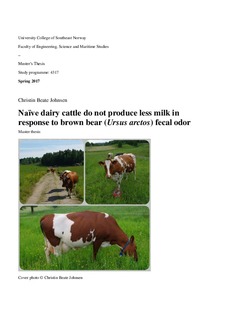| dc.description.abstract | Predators can have direct effects on prey by killing individuals, but may also have indirect effects caused by fear. Indirect effects may represent costs that can affect the individual fitness of prey by reducing growth, survival or reproduction, and on a population level predator-induced fear may cause effects in prey that can be more substantial than the direct effect of predation. Olfaction is an important sensory modality in mammals, which aids in the detection and avoidance of predators. In addition to direct encounters with a predator, the odor of the predator itself may act as a strong stressor, potentially eliciting behavioral - and physiological responses in the prey. Although costly anti-predator behaviors may be reduced or lost in the domestication process of animals, predator stimuli may still elicit similar responses in domestic species as in wild mammals. Conflict between large carnivores and livestock owners in Norway are severe. Brown bear (Ursus arctos) depredation on domestic sheep (Ovis aries) is considered to be one of the main problems for the conservation of brown bears, and sheep farmers are encouraged to shift to other income sources, such as dairy farming. An increasing bear population in the future may lead to more conflicts with dairy farmers as encounters between cattle and bears may increase, and bears can potentially cause negative indirect effects on cattle caused by fear. Farmers in Scandinavia have reported reduced milk production in cattle as a consequence of bear presence, which represents a risk of income loss for farmers. Here, I tested the hypothesis that milk production in naïve dairy cattle would be affected when experimentally exposed to brown bear odor (feces). I predicted that (i) milk yield would be lower when cattle are exposed to bear odor in comparison to when cattle are exposed to a herbivore odor (red deer (Cervus elaphus)), or a blank control (i.e., no odor), and (ii) that milk yield would be lower during experimental periods, when cattle are exposed to odor treatments, in comparison to before or after experimental periods. I found no support for these predictions as (i) no significant difference in mean milk yield among treatments was found (i.e., bear: 24.8±4.4 (SD), red deer: 24.2±4.6, blank: 24.4±5.1) and (ii) cattle produced significantly less milk before an experimental period, and produced significantly more milk during an experimental period when compared to after an experimental period (i.e., before: 22.8±5.1, during: 24.5±4.6, after: 24.6±4.9). Reasons for the lack of response in cattle to bear odor may be complex, but the lack of experience (e.g., depredation events) with bears is likely an important factor. Further research with dairy cattle experienced with bears are needed to gain a deeper understanding on how free-ranging cattle will respond physiologically to bear odor. | nb_NO |
